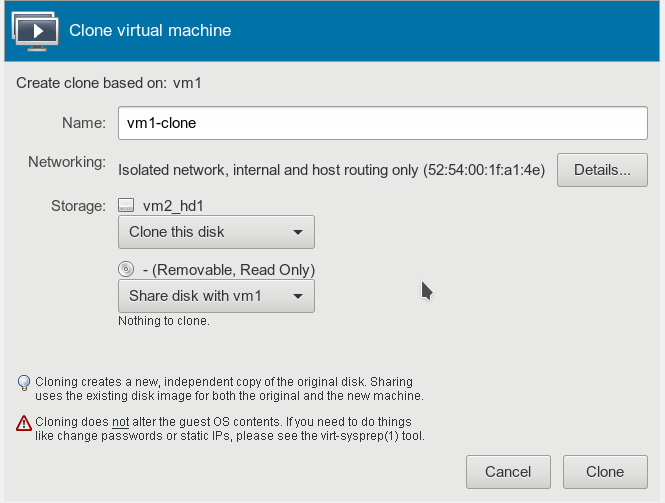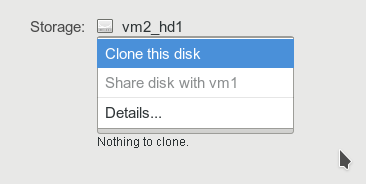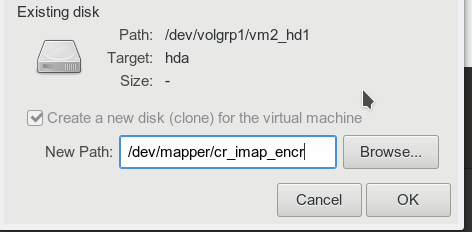Das Thema der vorhergehenden Artikel dieser Serie
DSGVO, Freelancer, E-Mails und Umzug KVM-virtualisierter Linux-E-Mail-Server auf verschlüsselte Platten/Partitionen – I
DSGVO, Freelancer, E-Mails und Umzug KVM-virtualisierter Linux-E-Mail-Server auf verschlüsselte Platten/Partitionen – II
war eine allgemeine Diskussion darüber, warum man sich spätestens nach der DSGVO als Freelancer um Schutzmaßnahmen für E-Mails und um entsprechende vertragliche Vereinbarungen kümmern sollte. Eine reine Verschlüsselung von Transportwegen ist meiner Meinung nach nicht hinreichend; eine Lagerung von Mails in verschlüsselten Dateicontainern ist mit zu vielen Gefahrenpunkten verbunden. An einer Verschlüsselung von Volumes oder Partitionen der mail- und datei-verarbeitenden Systeme führt bei der Aufbewahrung von Mails und Anhängen kein Weg vorbei.
Als Freelancer steht man also womöglich vor der Aufgabe, sowohl den eigenen Mail-Server im LAN als auch Clients zur Mail- und Auftragsbearbeitung auf einen Unterbau aus verschlüsselte Partitionen umzustellen. Als Linuxer, die auf effiziente Ressourcennutzung bedacht sind, greifen wir zur Lösung auf virtualisierte Systeme zurück. Sprich: Meine Reaktion auf die von etlichen Kunden an mich gestellten pauschalen DSGVO-Anforderungen ist, die Auftragsverarbeitung für Kunden nur noch über besonders geschützte virtualisierte Systeme auf verschlüsselten Volumes durchzuführen. Der aufmerksame Leser hat sicher bemerkt, dass dieser Gedanke über die Mail-Verarbeitung hinaus weist.
Ich gehe kurz auf die Grenzen eines solchen Vorgehens ein; anschließend kümmern wir uns (endlich) um den Umzug eines bereits virtualisierten Mailservers auf eine verschlüsselte HD/SSD-Plattform.
Der Grundgedanke einer Partitions- oder Volume-Verschlüsselung ist: Nur verschlüsselte Daten sollen über verschiedene Zugriffsschichten Plattencontroller und Magnet- wie Flash-Speicher erreichen; eine vollständige Entschlüsselung von Dateien soll ausschließlich im RAM des Betriebssystems [OS] stattfinden. So schön das sein mag – es hilft nicht, wenn sich jemand bereits unbefugt auf dem System eingenistet hat und munter mitliest:
Die Verschlüsselung von Datenträgern, Partitionen oder Volumes bietet keinen Schutz auf gehackten Systemen. Sie bietet “nur” Schutz gegen unbefugten Zugriff im nicht-entschlüsseltem und/oder nicht-gemountetem Zustand der Volumes also z.B. im heruntergefahrenen Zustand des Systems.
Volume-Verschlüsselung ist also nur eine – wenn auch eine wichtige Maßnahme – zur Ausschaltung bestimmter Risiken. Auch das sollte aus meiner Sicht in einem Vertrag mit einem Auftraggeber festgehalten werden. Natürlich muss man sich u.a. auch um die Integrität der Virtualisierungshosts selbst kümmern – wir reden da aber über Systeme mit einer sehr begrenzten Anzahl an OS-Komponenten, die selbst keine direkte Verbindung zum Internet aufnehmen müssen.
Man erkennt, dass ein vernünftiger DSGVO-bezogener Vertrag zum Schutz personenbezogener und anderer geheim zu haltender Daten im Endeffekt wesentlich mehr beinhalten muss als nur Hinweise auf die Mailbehandlung und zugehörige Krypto-Verfahren für Transport und Lagerung. U.a. wird man eine Begrenzung ein- und aus-gehender Kommunikation von (virtualisierten) Servern und Clients, die bei der Auftragsbearbeitung eingesetzt werden, auf nur sehr wenige erlaubte Adressen im Internet
umsetzen müssen. Z.B. gilt: Völlig offene HTTP(S)- / SMTP(S) – / IMAP(S)- oder gar UDP-basierte Kanäle nach außen zu beliebigen Zieladressen sind im Zeitalter von strafbewehrten DSGVO-Verträgen überhaupt keine gute Idee! Zumindest nicht auf denjenigen Server- und Client-Systemen, auf denen man mit geheim zu haltenden Informationen operiert.
Will man aus anderen grundlegenden Risikoerwägungen heraus nicht gleich alle “Volumes” auf allen Systemen im Haus-/Firmen-Netz verschlüsseln, bleibt nur der Weg über virtuelle Maschinen. Das betrifft dann Server- wie Client-Systeme gleichermaßen.
Im Besonderen Linux-E-Mail-Server sind dabei recht komplexe Systeme; eine Neuinstallation der vielen Einzel-Komponenten auf verschlüsselten Platten/Partitionen mag man sich daher wirklich ersparen. Es geht somit um System-Migration. Nachfolgend betrachte ich deshalb den Umzug eines (virtuellen) (E-Mail-) Servers auf einem KVM/QEMU-Host von unverschlüsselten Partitionen/Volumes auf verschlüsselte Volumes.
Ich gebe einige wichtige Befehle am Beispiel eines KVM/QEMU-Hosts unter Opensuse an. Das ist insofern nützlich, weil man hierfür mit YaST allein nicht auskommt und auf die Kommandozeile runter muss. Für einen Umzug voll ausgestatteter virtueller Clients (KVM/QEMU-Linux-Gastsysteme) zur Mail- und Auftragsbearbeitung gelten die Ausführungen dann analog.
Übrigens: Durch voll-virtualisierte KVM/QEMU-Systeme (für Mailserver und Clients),
- die netzwerktechnisch weitgehend abgeschottet sind,
- über die kein freier Internetzugang mit Browsern erlaubt ist
- und die auch nur spezielle Mail-Accounts bedienen
kann man auch Hackern das Eindringen ein wenig erschweren!
Das erste Problem besteht für manchen Leidensgenossen ggf. darin, einen schon vorhandenen physikalischen Server in eine Virtualisierungsumgebung zu bringen. Ehrlich gesagt, habe ich das noch nie selbst gemacht – und leider auch keine Zeit, das mal testweise auszuprobieren. Server für spezielle Aufgaben sind in meinem begrenzten Netz schon seit langem aus guten Gründen virtualisiert 🙂 .
Ich verweise für diese Aufgabe unter Linux deshalb auf sog. “P2V-Tools” (physical to virtual) und entsprechende Literatur. Die ganz unten aufgeführten Links geben hierzu Hinweise und Anleitungen. Für die nachfolgenden Schritte setze ich voraus, dass es bereits einen unter KVM/QEMU virtualisierten Server gibt – allerdings auf unverschlüsselten Partitionen/Volumes.
Kann man sich auf seinen Systemen eigentlich eine Verschlüsselungsschicht zusätzlich zur Virtualisierung leisten? Das ist eine gute Frage, die man pauschal schlecht beantworten kann. Unter Linux kommt meist eine Kombination aus dm-crypt und LUKS zum Einsatz. Für Systeme mit Prozessoren der letzten 5 Jahre sieht es dabei hinsichtlich der reinen Krypto-Performance recht gut aus. Bei Virtualisierungshosts im Heim-Bereich (also eher mit begrenzten Ressourcen) sind aber ein paar zusätzliche Punkte zu beachten:
Schichtung
Hat man als Plattenunterbau Raid-Systeme im Einsatz, so stellt sich etwa die Frage der Schichtung der verschiedenen Zugriffsverfahren. Aus meiner Sicht ist folgende Reihenfolge für virtualisierte Serversysteme sinnvoll:
- Plattenpartitionen für Raid >>
- Raid 10 >>
- LVM &
nbsp;>>
- Volumes für KVM-Host-OS >>
- dm-crypt/Luks für ein LVM-Raw-Volume >>
- KVM/QEMU- und Gastsystem mit Zugriff auf das Raw-Volume als virtuelle Platte >>
- LVM /Volumes (oder Partitionen) im Gastsystem >>
- ext4-Filesysteme im Gastsystem
Verschlüsselung vor Raid scheint mir aus naheliegenden Gründen wenig performance-optimierend zu sein. Bzgl. der Reihenfolge “LVM <> dm-crypt/Luks” kann man streiten. Für die eine oder andere Wahl ist aus meiner Sicht dabei nicht die Performance sondern die Flexibilität ausschlaggebend. Bei der von mir gewählten Vorgehensweise verschlüsseln wir LVM-Raw-Volumes und nicht die sie tragenden Platten-Partitionen. Das erlaubt den Einsatz unterschiedlicher Krypto-Algorithmen und individueller Passphrases für die zu verschlüsselnden Volumes. Ein Nachteil ist, dass Größenänderungen der Volumes und Filesysteme danach nicht im Online-Betrieb möglich sind. Das stört im semi-professionellen Umfeld aber weniger (s.u.).
Siehe auch:
https://superuser.com/questions/1193290/best-order-of-raid-lvm-and-luks
Einsatz von virtio-Treiber
Für optimale Performance setze ich auf dem KVM-Host für die Vermittlung des Zugriffs des KVM-Gast-Systems auf die als virtuelle HDs bereitgestellten Volumes den QEMU-eigenen “VirtIO”-Treiber ein. Das sieht im “virt-manager” dann etwa so aus:

Übernahme der Verschlüsselung durch den Virtualisierungs-Host!
Man erkennt an der oben angegebenen Schichtung, dass ich die Verschlüsselung vollkommen dem Virtualisierungs-Host überlasse. Das erscheint mir sinnvoll, da ihm normalerweise mehr CPU-Cores als dem Gastsystem zur Verfügung stehen.
Ich kann jedenfalls mit diesem Setup auf einem schon sehr betagten Host mit einem KVM-Gast-Mail-Server, der nur um die 10 Mails pro Minute verarbeiten muss, sehr gut leben. (Der Host beherbergt dabei noch mehr aktive virtualisierte Systeme!) Der Unterschied zur Situation ohne Verschlüsselung ist gefühlt klein. Soviel zum Mail-Server und Performance.
Gem. der oben propagierten Schichtung möchte ich das Gastsystem für meinen E-Mail-Server offenbar auf einem “Raw-Volume” der LVM-Schicht betreiben – also direkt auf einem LVM-Volume, das vom Gast-System aus formatiert wurde, und nicht auf einem “qcow2”-Loopback-File eines übergeordneten Filesystems des Hosts. Was spricht gegen ein Vorgehen mit “qcow2”-Dateien auf einem KVM-Host für einen virtualisierten Server?
“qcow2”-Dateien – mit internem Filesystem für den Gast – sind zwar hochflexibel einsetzbar – der Zugriff des Gastes auf seine virtuelle Platte erfolgt dabei aber immer über die Filesystem-Schicht des KVM/QEMU-Hosts UND über die Filesystem-Schicht des KVM-Gastes; das kostet Performance!
Der entsprechende Overhead ist nicht unerheblich – vor allem dann nicht, wenn der Server ggf. von mehreren Clients gleichzeitig genutzt werden soll. Die QEMU-Leute haben deshalb schon immer vorgesorgt und erlauben den direkten Zugriff eines Gastes auch auf nicht gemountete Volumes oder Partitionen des Hosts.
Der zweite
Grund entspringt ein wenig Sicherheitsüberlegungen.
Auf eine “qcow2”-Datei muss vom Gast-System über ein Mount-Verzeichnis des Host-Dateisystems aus zugegriffen werden. Die Datei liegt dann also bereits in einem unverschlüsselten Dateisystem, das auf einem Verzeichnis des Hosts gemountet ist, vor. Damit besteht aber auch – je nach Rechtesetzungen – die potentielle Gefahr, dass ihr Inhalt im laufenden Betrieb auch anderweitig ausgelesen werden kann (z.B. mit qemu-mount).
Die Situation ist im Fall von Raw-Devices komplexer. Das LVM-Volume wird nach einer Entsperrung des Verschlüsselungsverfahrens (s.u.) zwar wie eine Platte als Device unter “/dev/mapper” bereitgestellt. Aber dieses Device ist auch bei laufendem Gastsystem nicht direkt im Verzeichnisbaum des laufenden Host-Systems verankert. Ein evtl. durchgeführter Mountvorgang auf dem Host ist aber gar nicht so einfach zu verschleiern. Er wäre unnötig und würde bei entsprechender Protokollierung Alarmglocken auslösen.
Dennoch gilt:
Verschlüsselung von LVM-Volumes und Einsatz von qcow2 müssen bei hinreichenden Performance-Reserven kein Widerspruch sein.
Eine Schichtung
Raid 10 >> LVM >> dm-crypt/Luks-Volume mit ext4 >> Gemountetes LUKS/ext4-Volume mit qcow2-Datei auf dem KVM/QEMU-Host >> KVM/QEMU-Gast mit Zugriff auf qcow2-Loopback-Device >> LVM-Volumes des Gastsystems auf qcow2-Device >> ext4-Gast-Filesystem auf LVM-Volumes des Loop-Devices
funktioniert auf schnellen Hosts auch gut und bietet Verschlüsselung samt qcow2-Flexibilität. Ich nutze diese Variante u.a. auf Linux-Workstations für virtualisierte Clients.
Ich verfolge nachfolgend für unseren geplanten (Server-) Umzug aber die Variante ohne qcow2-Loopback-Device. Auch unser bisheriger virtualisierter (Mail-) Server mag bereits direkt auf einem unverschlüsselten Volume des Hosts verankert sein.
Wir können nun z.B. über den LVM-Volume-Manager von YaST oder über LVM-CLI-Kommandos (vgcreate, lvcreate) ein Raw-Volume kreieren, das nach seiner Verschlüsselung eine Kopie des alten Systems aufnehmen soll. Wie groß muss dieses logische Volume sein?
Naiverweise könnte man davon ausgehen, dass genau die Größe des alten Volumes (oder der alten Partition) in GiB hinreichend ist. Das wäre falsch. LUKS hinterlegt Informationen zum verschlüsselten Plattenplatz und zu 8 möglichen Passphrase-Keys in einem sog. “Verschlüsselungsheader“. Dieser Header benötigt zusätzlichen Platz jenseits der verschlüsselten Nutzlast. Der Platzbedarf ist zwar nicht groß (ca. 2 MB) – aber er ist eben zu berücksichtigen. Man muss dem neuen Volume etwas mehr Platz als dem alten spendieren. Ich vergebe meist gleich 1 GB extra.
In unserem Beispiel heiße das neue logische LVM-Volume für das virtuelle Plattendevice des KVM-Gastes “lvimap_hd0” und sei Teil einer LVM-Volume-Group “volgrp4”. Als Device erscheint dieses Volume dann unter “/dev/mapper” als “volgrp4-lvimap_hd0”.
myserv:~ # la /dev/mapper
...
lrwxrwxrwx 1 root root 8 Jun 10 09:40 volgrp4-lvimap_hd0 -> ../dm-14
...
Der zugehörige Link verweist im Beispiel dann ebenso wie “/dev/volgrp4/lvimap_hd0” auf “/dev/dm-14”.
Wir setzen zur Kryptierung “dm-crypt” ein. “dm-crypt” nutzt
LUKS über gut integrierte Module.
Die Aufgabe, ein (LVM-basiertes) “Raw-“-Device mit dmcrypt/LUKS zu verschlüsseln, lässt sich unter Opensuse Leap (42.2/42.3) entgegen jeder Erwartung mit YaST leider nicht erfolgreich durchführen. YaST wickelt die Anlage eines verschlüsselten Volumes nur dann korrekt ab, wenn das Filesystem bereits vorgegeben wird – also NICHT bei der Verschlüsselung für Raw-Devices innerhalb der Reihenfolge :
Partition >> LVM-Group >> Raw LVM-Volume >> dm-crypt/LUKS >> KVM-guest >> LVM im Gast >> Filesystem
Das ist bereits von anderen beklagt worden; siehe etwa:
https://forums.opensuse.org/ showthread.php/ 528938-installation-with-LUKS-cryptsetup-installer-gives-error-code-3034
Man muss also auf der Kommandozeile arbeiten und das Kommando “cryptsetup” bemühen. Für unser Beispiel-Volume “lvimap_hd0” (erste virt. Platte des künftigen E-Mail-Servers) lautet ein mögliches Kommando zur Verschlüsselung dann:
myserv:~ # cryptsetup luksFormat --hash=sha512 --key-size=512 --cipher=aes-xts-plain64 --verify-passphrase /dev/volgrp4/lvimap_hd0
Für Details zu den verfügbaren Verschlüsselungs- und Hash-Verfahren werfe man einen Blick in die man-Seiten zum Kommando. Man muss die künftige Passphrase zweimal eingeben. Damit ist die Verschlüsselung aktiv. Ein anschließender Blick auf das Volume mit dem YaST-Partitioner zeigt entsprechend ein Verschlüsselungssymbol an.
Bzgl. des geplanten Umzugs unseres unter KVM/QEMU virtualisierten (Mail-) Servers auf das neue Krypto-Device stellt sich nun die Frage, wie wir das am besten bewerkstelligen:
Sollen wir “dd” einsetzen? Das ist zwar möglich, erfordert anschließend aber wegen kopierter UUIDs, MAC-Adressen etc. etliche manuelle Nacharbeiten im geklonten System und auf dem Host.
Besser ist deshalb aus meiner Sicht ein Cloning mit Hilfe von virt-manager! Dabei ist folgende Schrittfolge einzuhalten:
- Schritt 1 : Öffnen des neuen dm-crypt-Devices unter einem verständlichen Namen
myserv:~ # cryptsetup open /dev/mapper/volgrp4-lv_imap_hd0 cr_imap_encr
Dabei muss natürlich die bereits gesetzte Passphrase für das Crypto-Device eingegeben werden. “cr_imap_encr” steht dann als ansprechbares Device unter “/dev/mapper/” bereit
- Schritt 2 : virt-manager öffnen und in der Liste der Gäste mit der rechten Maustaste auf den zu klonenden Gast klicken. Dann die Option “Clone …” wählen. Das führt uns dann zu einer Maske, die in etwa so aussieht und die zu klonende virtuelle Platte (vm2_hd1) des vorhandenen Gastes anbietet:

Bzgl. der zu klonenden Disk öffnet man die Drop-Down Box und wählt “Details” :

- Schritt 3 : In der sich neu öffnenden Maske trägt man den Pfad zum
geöffneten “dm-crypt”-Decvice ein:

Dann in der aktuellen Maske den “OK”-Button und anschließend in der Ausgangsmaske den Button “Clone” drücken.
Je nach Größe unseres virtuellen Servers und der Schnelligkeit der Plattensysteme wie des Prozessors dauert das etwas. Anschließend erhalten wir allerdings einen Clone, den man sofort booten kann. (Vorher den ursprünglichen Mail-Server natürlich runterfahren, um IP-Konflikte zu vermeiden. Das geklonte System hat immer noch die gleiche IP-Adresse wie das alte! )
Das war es im Wesentlichen schon. Wir haben erfolgreich ein virtualisiertes Server-System auf einen verschlüsselten LVM-Volume-Unterbau umgezogen!
Unsere manuelle Vorgehensweise hat dazu geführt, dass das verschlüsselte Volume nicht in Systemdateien eingetragen wurde. Es steht daher nach einem Boot-Vorgang des Hosts nicht automatisch zu Verfügung. Auch das Passwort für die Entschlüsselung wird im Bootvorgang nicht automatsich abgefragt.
Ein aktivierter “libvirtd”-Service kann daher nach seinem Start im Zuge eines Bootens des Hosts auch nicht auf das Volume für den umgezogenen Gast zugreifen. Ein automatisches Hochfahren des Gastes über libvirt-Einstellungen ist somit ebenfalls nicht möglich. Das sind Probleme, um die wir uns in nachfolgenden Artikeln kümmern müssen.
An dieser Stelle möchte ich aber wenigstens den notwendigen manuellen Befehl für das Schließen des Crypto-Devices im Zuge eines Herunterfahrens angeben:
In folgenden Artikeln möchte ich im Nachgang zu unserem “Umzug” ein wenig auf das Thema eingehen, wie man das Hochfahren des KVM-Hosts mit Gastsystemen auf verschlüsselten Volumes gestalten kann. Zudem wollen wir den “Verschlüsselungsheader” sichern und uns mit den Themen Backup und “fstrim” für SSDs als Basis der beschriebenen Schichtung befassen. Sinnvoll ist auch ein Blick auf (Mail-) Client-Systeme: Von irgendwo aus muss ja auch mal grafisch auf die virtualisierten Systeme zugegriffen werden. Dann werden z.B. Spice oder X2GO-Clients samt zugehörigen Protokollen zu einem Sicherheitsthema auf dem System, von dem aus wir auf virtualisierte Clients für die Auftragsbearbeitung zugreifen. Verschieben wir mit der Virtualisierung im Client-Umfeld also nur die Sicherheitsebene?
P2V-Tools
http://manuel.kiessling.net/2013/03/19/converting-a-running-physical-machine-to-a-kvm-virtual-machine/
http://libguestfs.org/virt-p2v.1.html
https://access.redhat.com/ documentation/ en-us/ red_hat_enterprise_linux/ 6/html/ v2v_guide/ chap-v2v_ guide-p2v _migration_ converting _physical _machines _to_virtual _machines
http://events17.linuxfoundation.org/sites/events/files/slides/virt-v2v-rjones-backup-slides.pdf
http://qemu-buch.de/de/index.php?title=QEMU-KVM-Buch/ _Speichermedien/ _Physical-to-Virtualp2v _migration _converting _physical _machines _to _virtual _machines
https://access.redhat.com/articles/1351473
dm-crypt/Luks und die Reihenfolge von Zugriffsschichten
https://superuser.com/ questions/ 1193290/ best-order-of-raid-lvm-and-luks
https://blog.raptor2101.de /2009/09/23/ verschlusselung-von-raids/
http://www.andreas-janssen.de/cryptodisk.html
http://linux-club.de/wiki/opensuse/Verschluesselung:_dm-crypt/luks_unter_openSUSE
https://wiki.archlinux.org/index.php/Dm-crypt/Specialties




